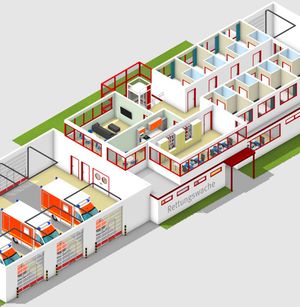KANBrief 3/17

The design of an ambulance station must satisfy the requirements of a range of regulations. Besides the building regulations, these include the state body of OSH regulations, and the body of rules and regulations of the German Social Accident Insurance Institutions. The particular aspects associated with use of the building following its construction must also be considered. This may cause considerable difficulties during planning of the building, which must satisfy all these requirements.
Ambulance stations are facilities in which ambulance crews spend their time whilst awaiting callouts. What principles however must be observed during their construction? During development of DIN 13049 (Rescue stations – Assessment basis and planning guide), the experts on the standards committee faced the question whether it is sufficient to formulate requirements for structures based upon experience gained in the field and upon the regional legislation governing ambulance services (further information in german), or whether the standard should also give consideration to the provisions of legislation governing work premises.
The construction, furnishing and operation of ambulance stations in Germany is subject among other legislation to the Ordinance on Workplaces (ArbStättV) and the technical rules for work premises pursuant to it (ASRs), and to the Ordinance on Biological Substances (BioStoffV). These contain requirements concerning the types of room to be provided and their dimensions (e.g. crew ready and break rooms, changing rooms, showers and toilets), and also the handling of infectious materials. On their own, the provisions of building regulations are thus not sufficient for ambulance stations to be planned such that they satisfy all occupational safety and health requirements during their use. Planners must therefore also pay close attention from the outset to the relevant occupational safety and health regulations, in order for operation of ambulance stations to be consistent with the legislation.
In practice, the question is how this can be achieved: in some of Germany's regions, building authorities are not responsible for occupational safety and health, and make reference when reviewing construction planning applications to the requirements of standards, but not to OSH-related rules and regulations. Once a building has been built, subsequent conversion work is difficult. A conflict exists here between construction law and the legislation governing work premises. The result of this conflict is not infrequently to the detriment of occupational safety and health.
Interplay between the body of OSH regulations and the standard
During the search for a solution to this problem, the closely related topic of firefighting was considered. In Germany, this sphere is governed by both the DIN 14092 series of standards on fire stations and DGUV informative publication 205-008 on safety in fire stations (DGUV-Information 205-008 „Sicherheit im Feuerwehrhaus“ (pdf, in german)). The standard, which is consistent with the relevant rules governing work premises, concerns issues relevant to planning, including the dimensions of the site; the DGUV informative publication addresses and details all OSH topics relevant to fire stations, including their operation.
A similar principle is now to be followed for the sphere of ambulance stations. The DGUV informative publication on safety at ambulance stations (DGUV-Information „Sicherheit im Stützpunkt einer Hilfeleistungsorganisation“ (pdf, in German)) and numerous technical rules already serve as a comprehensive body of rules and regulations for the construction and operation of such stations. The authors of DIN 13049, Rescue stations – Assessment basis and planning guide, first published in 2015 in draft form, sought to create a comprehensive basis for planning of the construction process beyond these two documents. The standard describes the types of rooms in ambulance stations and their floor areas. The standard is also recognized by the health insurance institutions as a tool for planning, and can be referred to by the ambulance services for invoicing of the costs.
Filling the gap with a standard
Problems arise when a standard imposes requirements upon rooms that are already governed to a large extent by the legislation concerning work premises. The policy document on the role of standardization in the safety and health of workers at work (pdf) states that other than in well-founded exceptional cases, standards projects should not be launched that fall wholly or partly within the scope of the safety and health of workers at work. In the case of ambulance stations, the OSH lobby has invoked the provision for an exception and has come out in favour of the standard, on condition that it does not conflict with the legislation governing work premises. In this case, the standard serves as an instrument by which the requirements of building regulations and the legislation concerning work premises can be reconciled at the planning stage.
KAN has consulted closely with the statutory accident insurance institutions, the VDSI and the standards committee and thereby ensured that the terminology and OSH requirements are implemented correctly in DIN 13049. In addition to a general comment in the foreword, the standard which was published in August 2017, now also contains clear references at all relevant points to the body of rules and regulations.
Rolf Reich
r.reich@ukbb.de
Michael Robert
robert@kan.de